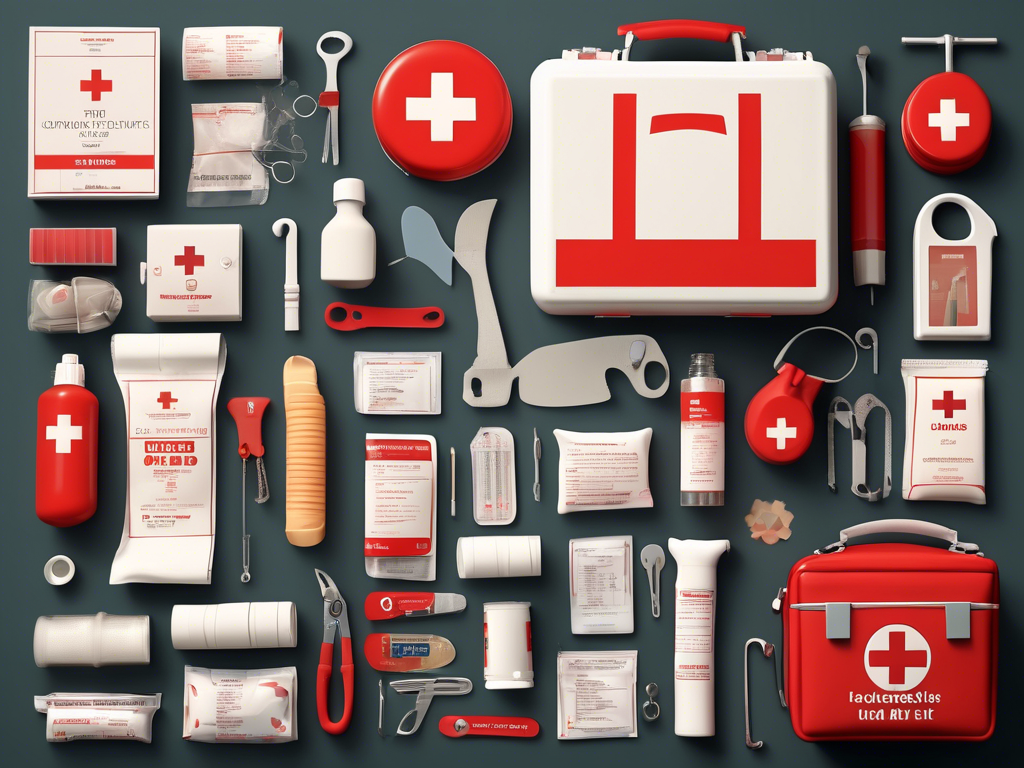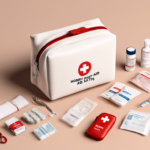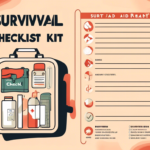In an unpredictable world where every moment can bring unforeseen challenges, being prepared is your best defense. Emergencies can strike at any time, whether it’s a minor cut in the kitchen, a roadside incident in your vehicle, or a more serious situation at home. This is why having a well-equipped first aid kit for home, kitchen, and automotive use is not just a recommendation but a necessity.
The importance of first aid cannot be overstated; it can mean the difference between a minor mishap and a major crisis. From culinary accidents that require immediate attention to unexpected incidents on road trips, understanding how to effectively assemble and utilize a first aid kit in a vehicle or a first aid kit for RV adventures is crucial. Moreover, specialized needs like a well-stocked lab first aid kit for laboratories ensure safety across various settings.
This comprehensive guide will explore essential components of a first aid kit—specifically tailored for your home, kitchen, vehicle, and beyond. We aim to deliver actionable insights on assembling an emergency medical kit for home and navigating the unique requirements of a laboratory first aid kit. By the end of this article, you’ll be equipped with the knowledge necessary to create and maintain effective first aid kits, ensuring that you are prepared for life’s little surprises.
Essential First Aid Kits: Equipping Your Home for Unexpected Emergencies
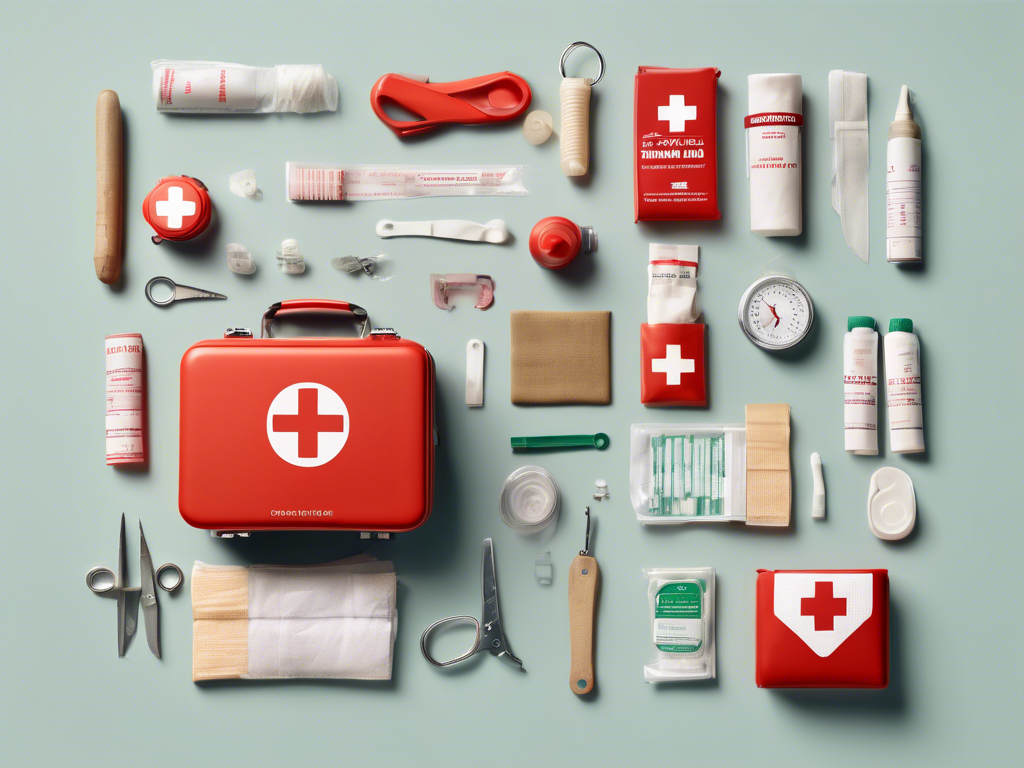
Preparing Your First Aid Kit for Home
A well-equipped first aid kit for home is essential for addressing minor injuries and emergencies that can happen at any time. Start with the basics, such as adhesive bandages, antiseptic wipes, gauze pads, and medical tape. It’s also wise to include a digital thermometer, scissors, tweezers, and a first aid manual. You may want to consider adding specific items based on your family’s needs, like allergy medication or burn ointment. 🏠
Outfitting Your Kitchen with a First Aid Kit
The kitchen is often the heart of the home, but it can also be a hotspot for accidents. A dedicated first aid kit kitchen should include items tailored for common kitchen mishaps. Stock it with items like burn dressings, instant cold packs, and hand sanitizer. Additionally, keep a few sterile gloves handy for situations where hygiene is critical. Having this kit within easy reach can provide peace of mind while you cook. 🍽️
Must-Have Items for a First Aid Kit in Vehicle
When you’re on the road, having a first aid kit in vehicle is crucial for unexpected incidents. Your automotive first aid kit should include reflective triangles, a flashlight, basic bandaging supplies, and pain relievers. Consider including an emergency blanket, a whistle, and a CPR mask to enhance safety for all passengers. Keeping this kit organized and easily accessible can make a significant difference during emergencies. 🚗
Essential Supplies for a First Aid Kit for RV
Traveling in an RV calls for specific preparations, so creating a first aid kit for RV is essential. In addition to standard first aid items, ensure your kit includes additional supplies like allergy medications, insect bite treatments, and a comprehensive travel-sized first aid guide. Given the nature of RV trips, consider adding a variety of tools including splints and emergency flares, which could be useful in more remote areas. 🏕️
Specialized Care: Laboratory First Aid Kit
For those working in a lab environment, a specialized laboratory first aid kit is non-negotiable. Stock it with items designed to handle risks associated with chemical spills, cuts, and burns. Include safety goggles, spill kits, and a selection of burn creams, as well as specific antidotes if applicable to the chemicals used. Regularly review and replenish your supplies to ensure compliance with safety regulations. ⚗️
Creating an Emergency Medical Kit for Home
An emergency medical kit for home should be comprehensive enough to handle severe injuries or medical conditions. This kit should include things like advanced first aid supplies, such as a tourniquet, emergency medications (like an epinephrine auto-injector), and a defibrillator if possible. Regular drills and training for your family on how to use the kit are equally important to ensure everyone knows how to respond in an emergency. ⛑️
The Must-Have First Aid Kit for Your Kitchen: Be Prepared for Culinary Mishaps

Essentials of a First Aid Kit Kitchen
When it comes to your culinary space, having a well-stocked first aid kit kitchen can make all the difference during unexpected mishaps. Focus on including items such as adhesive bandages for minor cuts, burn dressings for those unfortunate cooking accidents, and antiseptic wipes to prevent infection. Don’t forget to add a pair of scissors and a digital thermometer, as these tools can help manage various situations effectively. 🌡️
Specialized Supplies for Common Kitchen Injuries
Your kitchen is prone to specific types of injuries, so tailor your kit accordingly. Consider incorporating the following specialized supplies into your emergency medical kit for home:
– Instant cold packs for sprains or strains
– Sterile gloves to maintain hygiene
– Eye wash solution for accidental splashes
By preparing for these common scenarios, you can respond swiftly and effectively to any culinary incident. 🍳
Accessibility Matters in Your First Aid Kit for Home
Ensure that your first aid kit for home is easily accessible within the kitchen. Keep it in a designated drawer or cupboard that everyone can reach, especially in emergencies. Consider labeling the container clearly, so family members know where to find it quickly. Regular check-ups on the contents will ensure everything is stocked and ready for use when needed most. 🏃♀️
Integrating Your Kitchen Kit with Other First Aid Kits
While it’s crucial to have a dedicated kitchen kit, integrating its contents with other first aid kits around your home can enhance overall safety. For instance, share resources between your first aid kit in vehicle and your kitchen kit. Items like emergency blankets and basic bandaging supplies can serve multiple purposes. This not only maximizes the utility of your kits but also ensures readiness across locations. 🚑
Training Family Members on Using Your First Aid Kit
Equipping your kitchen with a first aid kit is just the first step; training family members on how to effectively use it is equally important. Conduct a family session where you familiarize everyone with the kit’s contents and demonstrate how to handle common injuries. This proactive approach ensures that in an emergency, everyone knows what to do, significantly improving response times and outcomes. ⏱️
On the Road Ready: Choosing the Right First Aid Kit for Your Vehicle
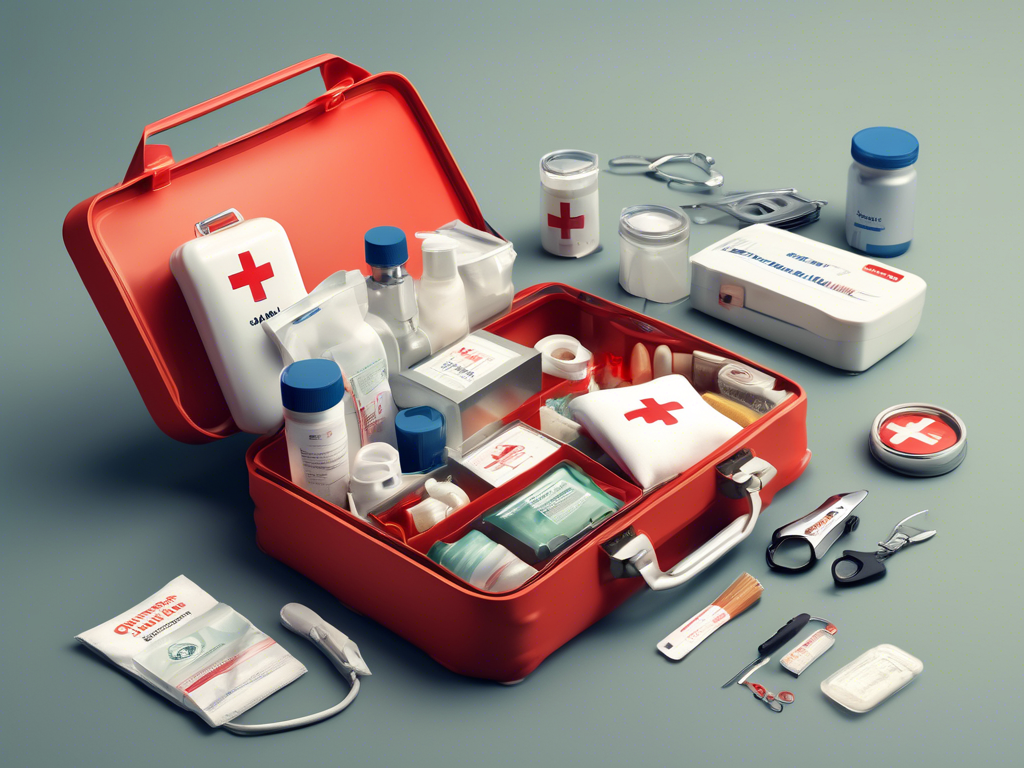
The Importance of a First Aid Kit in Vehicle
Having a well-stocked first aid kit in vehicle is essential for drivers and passengers alike. Accidents can happen at any moment while on the road, so being prepared can make all the difference. Your vehicle kit should include basic supplies such as adhesive bandages, antiseptic wipes, and gauze pads. Additionally, consider items that cater to specific automotive situations, like a flashlight and reflective triangles, which can help you signal for help in case of a breakdown. 🚑
Key Components of Your Automotive First Aid Kit
When assembling your first aid kit automotive collection, ensure it contains the following critical items:
– **Adhesive bandages** for small cuts and scrapes
– **Gauze pads and tape** for larger wounds
– **Instant cold packs** for swelling
– **Pain relievers such as ibuprofen**
– **CPR mask** for emergency resuscitation
– **Emergency blanket** to keep warm in cold weather
These essentials will allow you to handle minor injuries effectively while waiting for professional medical help if necessary. 🏥
Customizing Your First Aid Kit for RV Adventures
If you’re traveling in an RV, your needs may differ from those of an everyday vehicle. A first aid kit for RV should include additional supplies like antihistamines for allergies, insect bite treatments, and even splints for unexpected injuries during outdoor activities. Make sure to review the contents regularly and restock as needed, especially before embarking on long trips. This way, you’ll be prepared for both on-the-road and off-the-beaten-path emergencies. 🏞️
Organizing Your First Aid Kit in Vehicle
An organized first aid kit in vehicle is crucial for quick access during emergencies. Use a sturdy, waterproof container with clearly labeled sections for each type of item. This organization helps ensure that everyone knows where to find what they need without wasting time searching, ultimately improving your response time in critical situations. Consider keeping the kit in the trunk or under a seat where it is easily reachable but safely stowed away. 🚗
Periodical Checks and Updates for Your Automotive Kit
Regularly checking your first aid kit automotive is vital for ensuring that all items are in good condition and not expired. Make it a habit to inspect your kit at least every six months and whenever you take a road trip. Replace any used or damaged items, and consider adding new supplies based on your family’s specific health needs. Keeping your kit updated can provide peace of mind for all travelers. ⏰
Creating a Comprehensive Emergency Medical Kit for Your Home
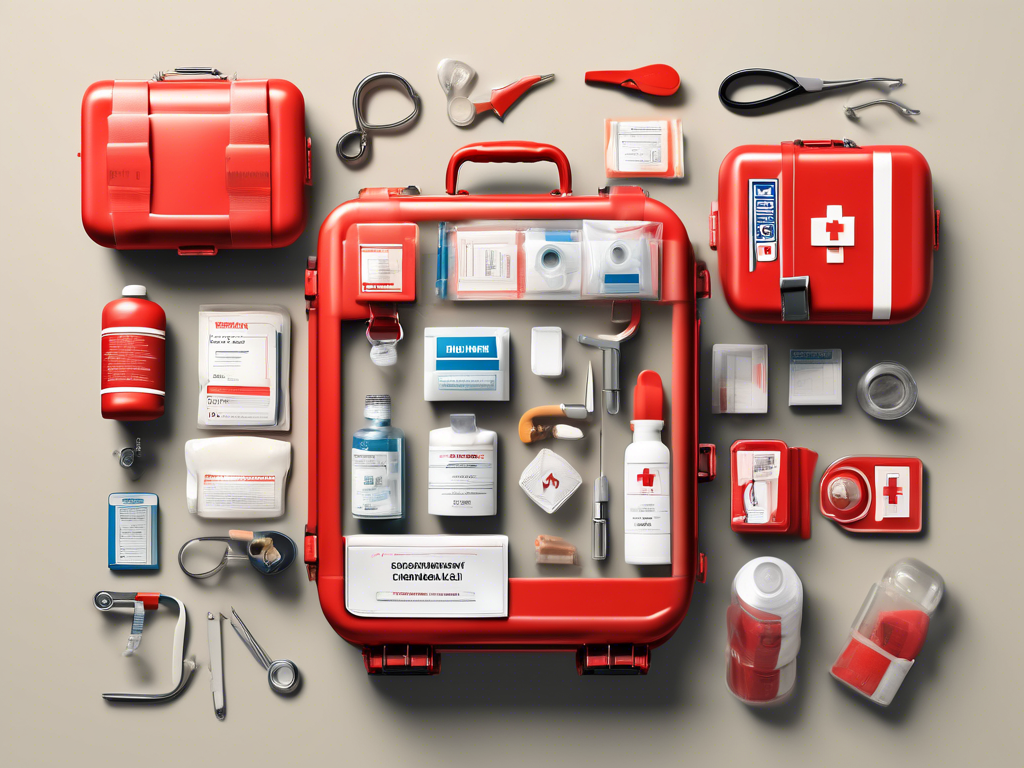
Key Components of an Emergency Medical Kit for Home
To build a well-rounded emergency medical kit for home, start by including essential supplies that can address a variety of injuries and medical emergencies. Key components to consider are:
– **Adhesive bandages** for minor cuts
– **Gauze pads** and **medical tape** for larger wounds
– **Antiseptic wipes** to prevent infections
– **Burn dressings** for cooking mishaps
– **Prescription medications** relevant to household members
Having these basics on hand ensures you are prepared for a range of scenarios, from small cuts to more significant emergencies. 🧑⚕️
Specialized Supplies for Unique Situations
Your home may have specific needs based on the activities and health conditions of your family members. Consider adding the following specialized items to your emergency medical kit for home:
– **Allergy medications** for known allergies
– **Epinephrine auto-injectors** for severe allergic reactions
– **Thermometer** for monitoring fevers
– **Splints** for immobilizing broken limbs
– **CPR face shield** for resuscitation in emergencies
Being proactive about these additions can significantly enhance your readiness for specific medical situations, ensuring everyone in your household is safe. ⚠️
Storage Solutions for Easy Access
An organized storage solution is crucial for your emergency medical kit for home to be effective during a crisis. Choose a clear, waterproof container that is labeled appropriately. Keep it in a central, easily accessible location known to all family members. Regularly check the contents to ensure everything is well-stocked and not expired. A well-maintained kit allows for quick response whenever needed. 🗂️
Training Family Members on Emergency Procedures
Having a comprehensive kit is only half the battle; educating your family on how to use it is vital. Conduct simple training sessions to familiarize everyone with each item in the emergency medical kit for home. Teach essential procedures such as how to apply bandages or when to use an epinephrine auto-injector. This knowledge can save lives and instills confidence in dealing with emergencies. 🎓
Integrating Your Home Kit with Other First Aid Kits
Consider integrating your emergency medical kit for home with other first aid kits around your property, such as those in the kitchen, automotive, or RV. This approach helps maximize resources while maintaining preparedness across various locations. Ensure that all kits share vital items like antiseptics and bandages, and regularly update them to reflect any changes in your household’s needs. This strategy promotes efficiency and readiness during emergencies. 🚀
First Aid Kits for RV Adventures: Safety on the Go
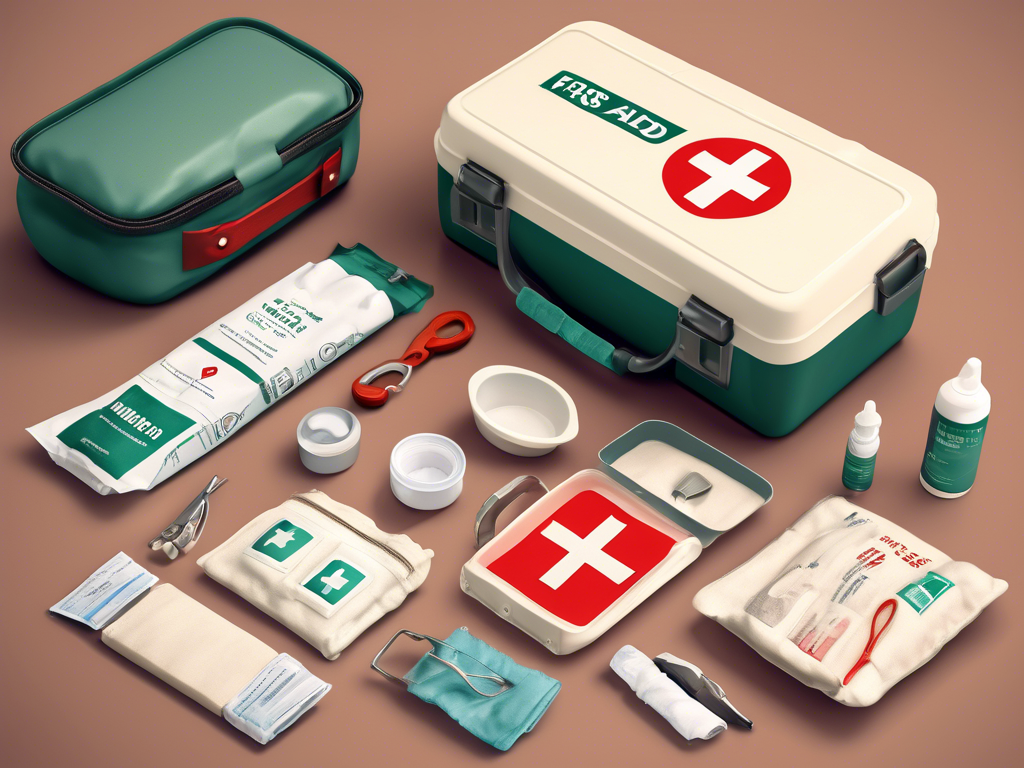
The Necessity of a First Aid Kit for RV
When embarking on an RV adventure, having a dedicated first aid kit for RV is crucial for ensuring safety on the road and during your outdoor activities. Your kit should encompass not only standard first aid supplies but also items specifically tailored to the unique risks associated with camping, hiking, and travel. Essential supplies include adhesive bandages, antiseptic wipes, pain relievers, and specific medications for allergies or insect bites. Being prepared allows you to handle minor injuries effectively while enjoying your journey. 🚐
Customizing Your Emergency Medical Kit for Home Away from Home
Your RV’s emergency medical kit for home should be thoughtfully customized to meet the needs of your traveling family. Consider adding:
– **Cold packs** for strains or sprains
– **Burn ointments** for cooking mishaps
– **Splints** for potential fractures during outdoor excursions
– **Bug bite treatment** to soothe irritation from insects
By catering to these possibilities, you’ll ensure that you’re ready for various situations while exploring the great outdoors. 🏞️
Organizing Your First Aid Kit in Vehicle
Organization is key when it comes to your first aid kit in vehicle, especially in an RV where space might be limited. Use a compartmentalized, waterproof container to keep supplies sorted and easy to access. Clearly label each section for quick retrieval—this will save precious time during emergencies. Ensure the kit is stored in a location that’s both reachable and secure, such as under a seat or within a designated drawer. 🚙
Periodical Checks: Maintaining Your First Aid Kit for RV
Regular checks of your first aid kit for RV are essential for ensuring all items are in good condition and ready for use. Make it a routine to inspect your kit every few months, especially before long trips. Replace any expired medications, re-stock essential supplies, and consider the specific health needs of your family that might require additional items. Keeping your kit updated can significantly enhance safety during your adventures. ⏳
Teaching Family Members About Your RV First Aid Kit
Equipping your RV with a first aid kit is just one step; educating family members on its contents and proper usage is equally important. Conduct training sessions where you demonstrate how to apply bandages, use a CPR mask, and recognize the appropriate times to utilize the supplies. This knowledge empowers everyone to act confidently in case of an emergency, making your travels safer and more enjoyable. 📚
Setting Up a Lab First Aid Kit: Essential Supplies for Every Laboratory
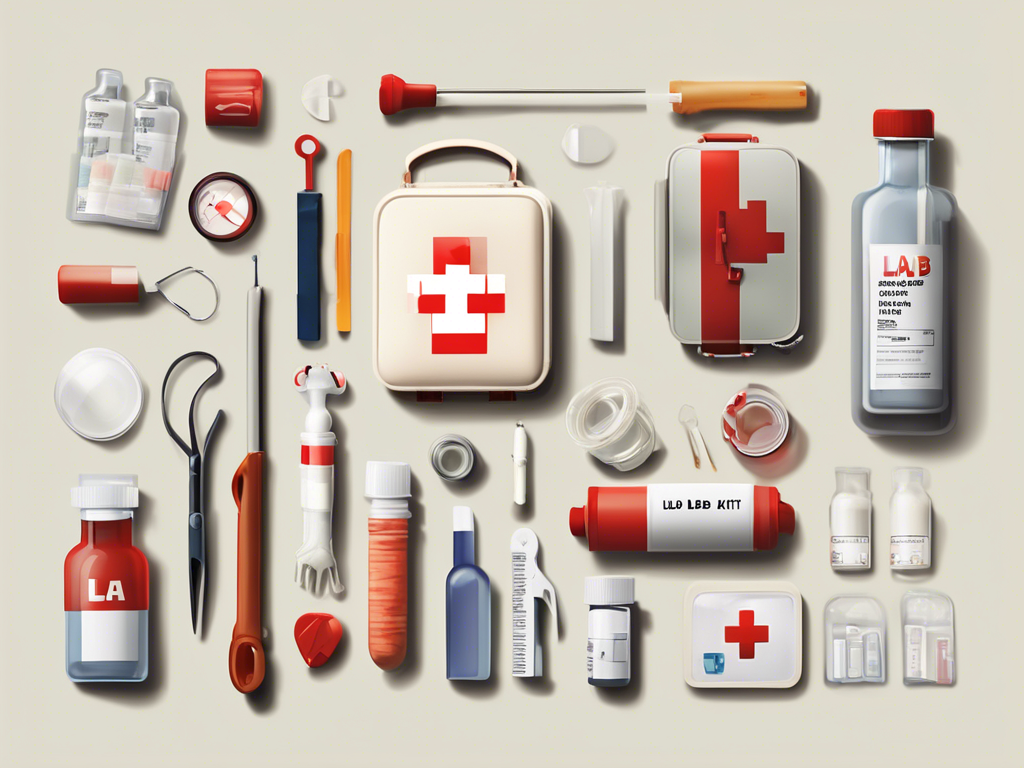
The Importance of a Laboratory First Aid Kit
A dedicated laboratory first aid kit is vital for ensuring safety in environments where chemicals, sharp instruments, and other hazards are commonplace. This specialized kit should be equipped to address a variety of potential injuries, such as cuts, burns, or chemical exposures. Having the right supplies on hand can help mitigate the risks associated with lab work and ensure quick response times in emergencies. ⚗️
Must-Have Supplies for Your Lab First Aid Kit
When assembling your lab first aid kit, focus on including these essential supplies:
– **Adhesive bandages** for minor cuts and abrasions
– **Gauze pads** and **medical tape** for larger wounds
– **Burn creams** for instances of thermal injuries
– **Safety goggles** to protect eyes from splashes
– **Eye wash solution** for immediate rinsing of contaminated eyes
– **Chemical spill kits** to manage hazardous material incidents
Including these items ensures that your lab is well-prepared for most common injuries and accidents. 🧪
Customizing Your Emergency Medical Kit for Home with Lab-Specific Needs
In addition to general first aid supplies, consider customizing your emergency medical kit for home to include lab-specific needs that may arise. For instance:
– **Antidotes** for specific chemicals used in the lab
– **Nitrile gloves** to maintain hygiene and safety during treatment
– **Thermometer** for monitoring temperature in case of heat-related injuries
– **Splints** for immobilizing injuries caused by equipment accidents
By tailoring your kit to accommodate laboratory-related incidents, you can effectively handle unique emergencies that may occur. 🩺
Accessibility and Organization of Your Laboratory First Aid Kit
Ensure that your laboratory first aid kit is easily accessible to all staff members. Store it in a designated area that is clearly marked and known to everyone in the lab. Organizing the supplies within the kit can enhance efficiency; use a waterproof container with labeled sections for different types of items. Regularly check the contents to replace expired supplies and maintain readiness. 🚦
Training Lab Personnel on Proper Use of the Lab First Aid Kit
Having a well-stocked lab first aid kit is only effective if lab personnel know how to use it properly. Conduct training sessions that familiarize team members with the kit’s contents and demonstrate how to handle common lab injuries. Encourage participation in emergency drills to reinforce procedures, ensuring that everyone feels confident and prepared to respond in a crisis. 📖
Automotive First Aid Kits: Your Guide to Preparing for Roadside Emergencies
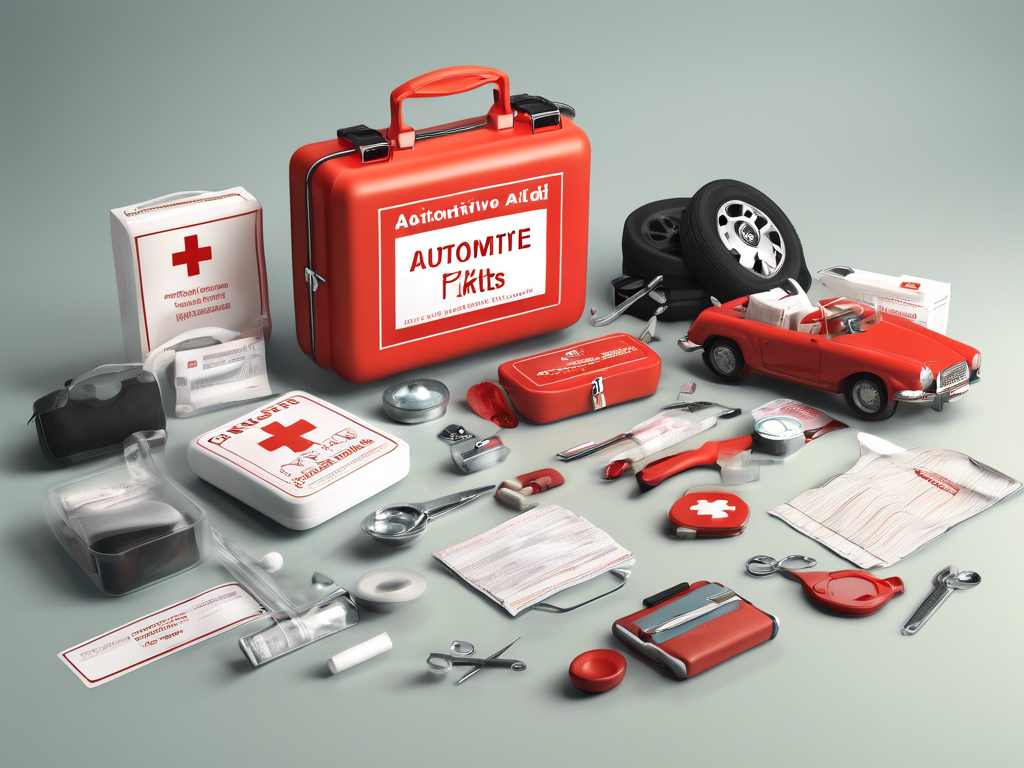
The Necessity of a First Aid Kit Automotive
Having a dedicated first aid kit automotive is crucial for drivers and passengers alike. When you’re on the road, injuries can occur unexpectedly, making it vital to be prepared. Your kit should include basic supplies such as adhesive bandages, antiseptic wipes, and gauze pads. Additionally, consider adding items tailored to automotive situations, like reflective triangles and a flashlight to signal for help if needed. Being proactive about emergency preparedness can significantly reduce stress during roadside incidents. 🚗
Key Components for Your First Aid Kit in Vehicle
A well-stocked first aid kit in vehicle can be a lifesaver. Consider including the following essential items:
– **Adhesive bandages** for small cuts and scrapes
– **Gauze pads and medical tape** for larger wounds
– **Instant cold packs** to reduce swelling
– **Pain relievers** such as ibuprofen or acetaminophen
– **CPR mask** for resuscitation emergencies
– **Emergency blanket** for warmth if stranded
These supplies will allow you to manage minor injuries effectively while awaiting professional help. 🏥
Customizing Your First Aid Kit for RV Travels
If your adventures involve an RV, it’s significant to customize your first aid kit for RV to meet specific needs. In addition to standard supplies, add:
– **Antihistamines** for allergy relief
– **Insect bite treatments** for outdoor excursions
– **Splints** for immobilizing any suspected fractures
Make sure to review and replenish your kit regularly, especially before long trips. This ensures readiness for both on-the-road and off-the-beaten-path emergencies. 🏞️
Organizing Your First Aid Kit in Vehicle
An organized first aid kit in vehicle is essential for quick access during emergencies. Use a waterproof container with labeled sections for each type of item. This organization helps ensure that everyone knows where to find what they need promptly, improving your overall response time. Keep your kit in your trunk or under a seat where it remains secure yet easily reachable. 🧰
Regular Maintenance: Checking Your First Aid Kit Automotive
Maintaining your first aid kit automotive is vital to ensure all items remain usable and accessible. Make it a habit to inspect your kit every six months and after any long-distance trips. Replace any used or expired items and consider adding new supplies based on your family’s health needs. A well-maintained kit brings peace of mind for all travelers, knowing you are ready for any situation that may arise. ⏰
A Kitchen First Aid Kit: Key Items to Handle Cooking Accidents
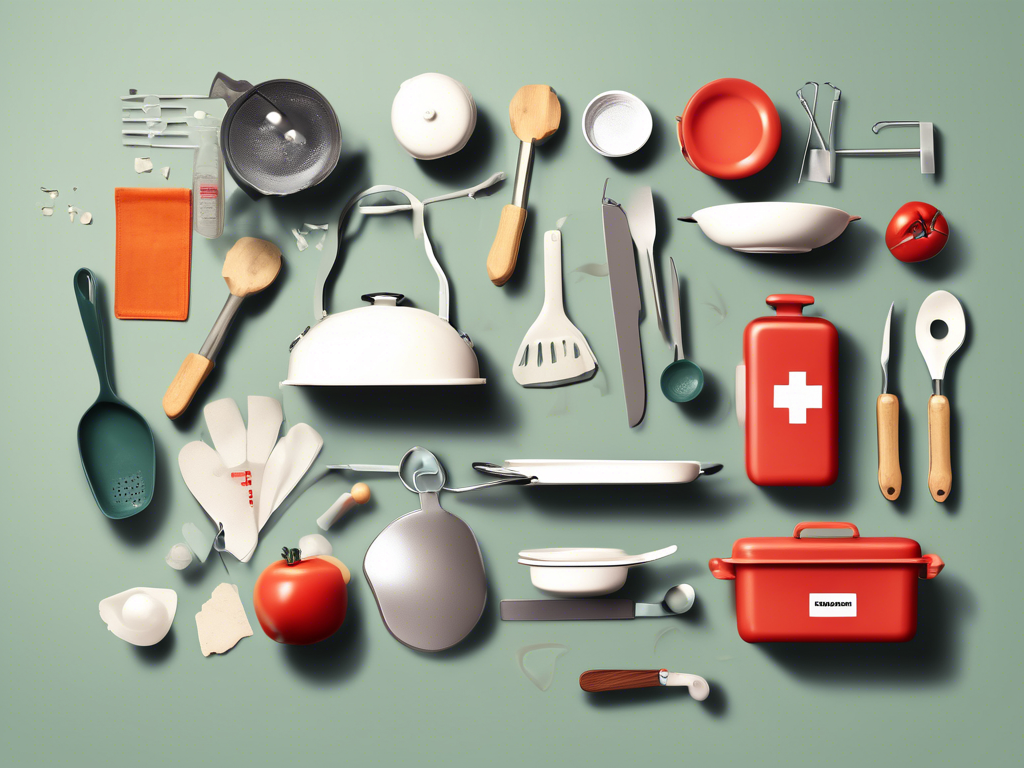
Essential Supplies for Your First Aid Kit Kitchen
Stocking your first aid kit kitchen with the right supplies is crucial for managing minor injuries that occur while cooking. The essential items should include:
– **Adhesive bandages** for small cuts
– **Burn dressings** specifically designed to soothe burns
– **Antiseptic wipes** to clean wounds and prevent infection
– **Instant cold packs** to reduce swelling from accidental bumps or strains
These supplies will help you address common kitchen mishaps effectively, ensuring a safer cooking environment. 🍳
Addressing Common Cooking Injuries
Being prepared for specific injuries can make a significant difference in responding to accidents. Include these specialized items in your emergency medical kit for home:
– **Eye wash solution** for rinsing splashes from your eyes
– **Sterile gloves** for maintaining hygiene during treatment
– **Scissors and tweezers** for cutting bandages or removing splinters
By anticipating the types of injuries that may occur in your kitchen, you’ll be ready to act swiftly when emergencies arise. 🔪
Accessibility is Key for Your First Aid Kit for Home
To enhance safety, ensure your first aid kit for home is easily accessible. Store it in a designated drawer or cabinet away from food but within arm’s reach. Clearly label the container so family members can quickly find it during emergencies. Regularly inspect the contents to replace used or expired items, keeping the kit well-stocked and ready for action. 🏡
Integrating Your Kitchen First Aid Kit with Other First Aid Kits
To maximize preparedness, consider integrating items from your first aid kit in vehicle with your kitchen kit. For example, sharing supplies like antiseptics and gauze pads between both kits ensures critical resources are available wherever needed. This approach not only expands the utility of your kits but also reinforces safety across your home and vehicle environments. 🚗
Training Family Members on Using Your First Aid Kit
Education is vital; therefore, take time to train your family on how to use your first aid kit effectively. Conduct a brief session to go over the items included and demonstrate the proper way to treat common injuries. This knowledge empowers everyone to respond confidently in emergencies, improving the overall safety of your kitchen activities. 📚
Home Safety: How to Assemble an Effective First Aid Kit for Every Room
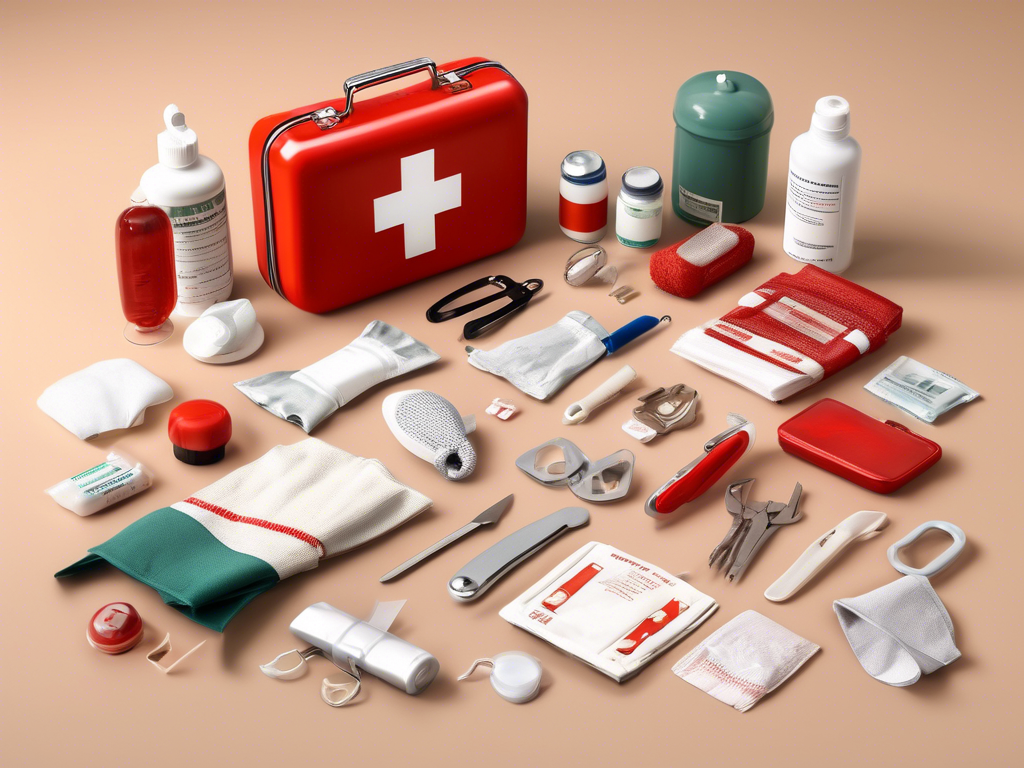
Creating a Comprehensive First Aid Kit for Home
A well-stocked first aid kit for home is crucial for addressing accidents and injuries that can happen anywhere. Start with essential items like adhesive bandages, antiseptic wipes, gauze pads, and medical tape. Don’t forget to include a digital thermometer, scissors, tweezers, and a first aid manual. Each room in your home may require specific items based on its activities, so consider tailoring your kits accordingly to enhance overall safety. 🏠
Essential Supplies for Your First Aid Kit Kitchen
In the kitchen, a dedicated first aid kit kitchen should focus on common culinary mishaps. Stock it with:
– **Burn dressings** for minor cooking burns
– **Instant cold packs** to reduce swelling
– **Hand sanitizer** for keeping hands clean during treatment
– **Sterile gloves** to maintain hygiene
Having these items readily available can help you effectively manage injuries right where they occur. 🍽️
Equipping Your First Aid Kit in Vehicle for Road Safety
For those who frequently travel, incorporating a first aid kit in vehicle is vital. Ensure your kit includes:
– **Reflective triangles** for signaling roadside assistance
– **Flashlight** for visibility in emergencies
– **Basic bandaging supplies** for injuries on the go
This preparation can alleviate stress and enhance safety when unexpected situations arise while traveling. 🚗
Preparing a First Aid Kit for RV Adventures
When it comes to RV trips, customize your first aid kit for RV with additional supplies that cater to outdoor adventures. Include items such as:
– **Allergy medications** for outdoor exposure
– **Insect bite treatments** to soothe irritation
– **Emergency flares** for signaling in remote areas
Review your kit regularly to make sure you’re equipped for any potential incidents during your travels. 🏕️
Special Considerations for a Laboratory First Aid Kit
In a laboratory setting, having a specialized laboratory first aid kit is critical. It should contain relevant items like:
– **Safety goggles** for eye protection
– **Spill kits** for managing chemical exposure
– **Burn creams** for thermal injuries
Ensure you regularly assess and update the kit’s contents to comply with safety regulations and facility needs. ⚗️
Regular Maintenance: The Key to Your Emergency Medical Kit for Home
An emergency medical kit for home must be well-maintained to function effectively. Schedule periodic checks—every three to six months—to ensure all items are intact and not expired. Replenish supplies as needed, and educate all family members on the kit’s location and usage. This ongoing commitment to maintenance enhances readiness for any situation that may arise. ⛑️
Summing up
In summary, equipping your home, kitchen, and vehicle with the appropriate first aid kits is an essential aspect of personal safety and preparedness. Whether you find yourself dealing with a minor burn while cooking or facing a more severe incident on the road, having the right supplies can significantly impact outcomes during emergencies.
Throughout this guide, we’ve emphasized the importance of customizing your first aid kit for home environments, preparing a practical first aid kit for your kitchen, and selecting the right components for your automotive first aid kit. Additionally, we’ve highlighted unique considerations for RV enthusiasts and the specific needs for a lab first aid kit. Each of these scenarios showcases the need for preparedness tailored to your lifestyle.
By taking actionable steps to enhance your readiness—whether by organizing an emergency medical kit for home or ensuring your vehicle is stocked with necessary supplies—you take control of your safety and the safety of those around you. As you move forward, consider reviewing your kits regularly to adapt to changing needs or circumstances. The best time to prepare is before an emergency strikes; don’t wait to be caught off guard. Gather your supplies today and embrace peace of mind, knowing you’re equipped to handle whatever life throws your way.
